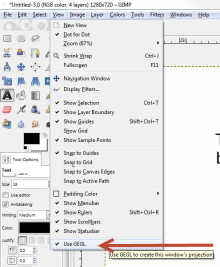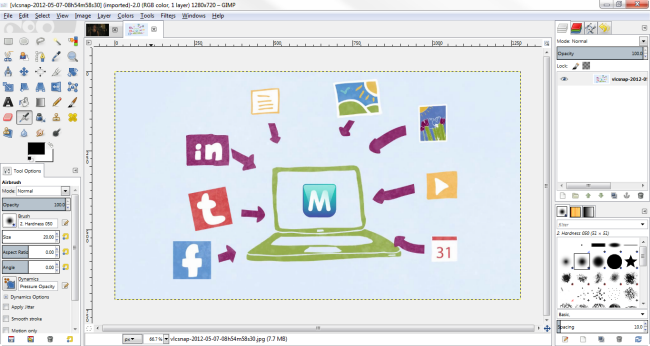Article
GIMP updates to version 2.8
- May 7, 2012
- Updated: July 2, 2025 at 8:50 AM
 GIMP has been one of my favorite image editing tools for years because of its price (free) and powerful feature set. Still, GIMP drew plenty of criticism for having a confusing interface. The developers of GIMP are well aware of these issues and have targeted this issue in the latest release of GIMP. Besides some interface tweaks, GIMP also comes with slew of technical improvements. Let’s take a look at some of the major changes in version 2.8 of GIMP.
GIMP has been one of my favorite image editing tools for years because of its price (free) and powerful feature set. Still, GIMP drew plenty of criticism for having a confusing interface. The developers of GIMP are well aware of these issues and have targeted this issue in the latest release of GIMP. Besides some interface tweaks, GIMP also comes with slew of technical improvements. Let’s take a look at some of the major changes in version 2.8 of GIMP.
Single-window mode
One of the biggest criticisms of GIMP in the past was that its floating window interface made it a pain to organize and use its tools. While GIMP 2.8 still defaults to this windowed mode, users can choose to select the new “single-window mode” where all the tools and image canvas are unified in a single window. This dramatically cleans up the interface and makes looking at multiple projects a breeze with its tabbed interface. Unfortunately, users cannot view two projects side by side.
On canvas text editing
GIMP has improved text editing dramatically. Before, a little window popped up to enter text but you had to go under the tools section to make any edits to the text formatting. GIMP 2.8 has improved this process by moving all of the options for text editing to show up on canvas. Editing the font, text size, and color are all options available in the on canvas popup menu.
Separation of save and export
Previous versions of GIMP allowed users to save their images into a number of different formats, but GIMP 2.8 changes this by only allowing users to save projects as XCF. This makes sense as XCF is the only format in which GIMP saves all the different layers and individual modifications. Saving to another format in previous versions of GIMP would flatten the image. Users can still get images in different formats like JPEG and PNG, but will have to export them instead of saving them.
Nested layers
GIMP 2.8 introduces nested layers, which helps to keep your layers organized. Having layers organized in a tree structure ensures you know which sublayer belongs to which layer. Layer groups are scriptable by using GIMP’s API.
Better multi-monitor support
Users with multiple monitors will enjoy this update as it allows the grouping of docked windows to be placed in columns. The advantage of this is that one monitor can be dedicated to the canvas while the other is dedicated to tools and dock window.

Generic Graphics Library (GEGL)
While this feature isn’t new, GIMP 2.8 is the first stable, consumer version of GIMP to include the ability to use the GEGL. The advantage of using GEGL is “high bit-depth and non-destructive editing,” according to its developers. This means that image processing supports “32bit floating point linear light RGBA” but the old 8bit processing is still available in the program.
Version 2.8 of GIMP is a long awaited updated that was three years in the making. It shows that GIMP’s developers are dedicated and serious about improving the user experience of their application and pushing technical boundaries. GIMP has a bright future ahead of it. Personally, I cannot wait to see what its developers come up with next.
You may also like
 News
NewsWhat is Fantastic Frontiers? The new trend that Adobe Firefly helps you create effortlessly
Read more
 News
NewsChatGPT launches its App Store: how it works and what we can do with it
Read more
 News
NewsEscape From Tarkov has sold over a million copies in its first month
Read more
 News
NewsThe leading medical series of recent years returns with a second season
Read more
 News
NewsThe producer of one of the most controversial remakes of the year wouldn't change anything about the game
Read more
 News
NewsKanye West wanted to make a game with Nintendo, but Nintendo had other plans
Read more
